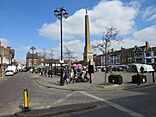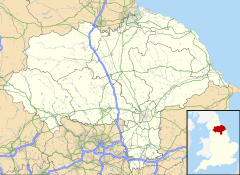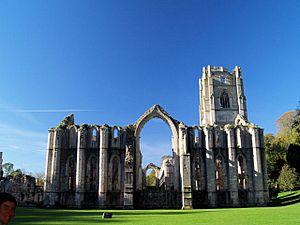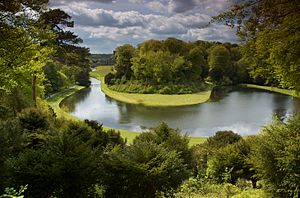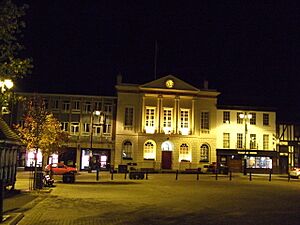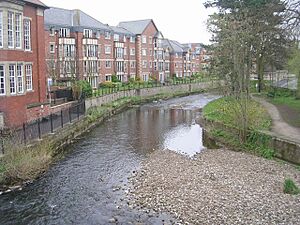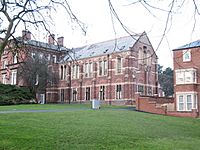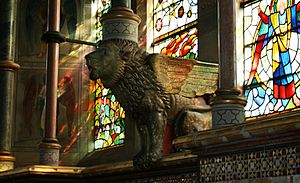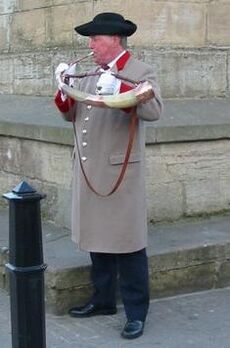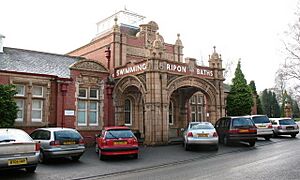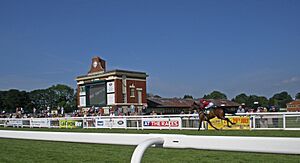Ripon facts for kids
Quick facts for kids Ripon |
|
|---|---|
| City | |
|
Clockwise from top left: the Market Place, Ripon Cathedral, Newby Hall, Fountains Abbey and the Cabmen's Shelter |
|
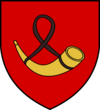 Coat of arms |
|
| Population | 16,702 (2011 census) |
| OS grid reference | SE312714 |
| • London | 227 mi (365 km) SSE |
| Civil parish |
|
| Unitary authority |
|
| Ceremonial county | |
| Region | |
| Country | England |
| Sovereign state | United Kingdom |
| Post town | RIPON |
| Postcode district | HG4 |
| Dialling code | 01765 |
| Police | North Yorkshire |
| Fire | North Yorkshire |
| Ambulance | Yorkshire |
| EU Parliament | Yorkshire and the Humber |
| UK Parliament |
|
| Website | www.ripon.org |
Ripon (/ˈrɪpən/) is a city in North Yorkshire, England. It is located where two rivers, the Laver and Skell, meet the River Ure. Ripon is well-known for its beautiful Ripon Cathedral, its horse racing track (Ripon Racecourse), and its lively market.
The city was once called Inhrypum. A long time ago, in the 7th century, a monastery was built here by Wilfrid, who later became an important religious leader. This was during the time of the Anglian kingdom of Northumbria, when Ripon was very important for religion in Great Britain. Later, it was controlled by Vikings and then the Normans. After some building projects, Ripon became famous for making wool and cloth. In the 16th and 17th centuries, it was known for making spurs (for horse riding). The Industrial Revolution didn't change Ripon much.
Ripon is the third-smallest city in England by population, and the smallest in Yorkshire. In 2011, about 16,702 people lived there. It's about 11 miles (18 km) south-west of Thirsk and 12 miles (19 km) north of Harrogate. Besides its cathedral and racecourse, Ripon is a popular place for tourists. Many people visit because it's close to the UNESCO World Heritage Site of Studley Royal Park and Fountains Abbey.
Contents
History of Ripon
Early Times: Northumbrians and Vikings
Before Ripon was founded, the area was home to the Brigantes, a Celtic tribe. About 3 miles (5 km) north of Ripon, you can still see a large circular earthwork they built. The Romans didn't settle in Ripon, but they had a military outpost nearby.
The city of Ripon truly began in the 7th century, during the time of the Anglian kingdom of Northumbria. The first building was a Christian church dedicated to Saint Peter, built in 658. This church was founded by a nobleman named Wilfrid, who was given the land by King Alhfrith.
The first settlers in Ripon were skilled workers like stonemasons and glaziers. Wilfrid brought them from places like Lyon in France and Rome to help build the Ripon monastery. After Wilfrid's death, Ripon's history is a bit unclear for a while. Later, Norse Vikings invaded Northumbria and set up the Danelaw. The Kingdom of Jórvík was formed in Yorkshire.
In 937, Athelstan, the King of England, gave Ripon the special right of sanctuary. This meant that people could find safety within a mile around the church. However, in 948, after Northumbrians rebelled against English rule, King Edred had the buildings in Ripon burned down. By the end of the 10th century, Ripon became prosperous again. The body of Cuthbert was even moved to Ripon for a time to protect it from Danish raids.
Normans and the Middle Ages
After the Norman conquest in 1066, many people in the north rebelled. This led to a harsh response known as the Harrying of the North, which caused many deaths. Ripon likely became a very small community around the church after this.
The church lands were given to St. Peter's Church in York. During this time, a grand Collegiate Church was built on the ruins of Wilfrid's old building. This church was built in the Gothic style. In the 12th century, Ripon became a busy center for the wool trade. Italian merchants, especially from Florence, came to buy and sell large amounts of wool.
Ripon was close to Fountains Abbey, where Cistercian monks were experts in sheep farming and owned a lot of land. This was a big advantage for Ripon's wool trade. After 1326, English people were not allowed to wear foreign cloth. This helped Ripon's cloth industry grow, becoming the third largest in Yorkshire.
During the time of King Edward I and Edward II, there were many conflicts with Scotland. Scottish invaders attacked many northern English towns. Ripon had a "wakeman" whose job was to make sure everyone was safely home by curfew and that law and order were kept. Once, Ripon had to pay a large sum of money to the Scots to stop them from burning down the town.
Reformation and Tudor Times
Ripon relied a lot on its religious buildings, so it was greatly affected by the English Reformation under King Henry VIII. The head of Fountains Abbey, William Thirske, was removed by Henry. Thirske then became a leader in the Pilgrimage of Grace, a popular uprising. People in Northern England were unhappy about Henry's decision to break away from the Catholic Church.
The revolt failed, and Henry went ahead with the break from Rome and the Dissolution of the Monasteries, which included Fountains Abbey.
Later, Mary, Queen of Scots, stayed in Ripon while fleeing Scotland. The mostly Catholic North supported her. Another uprising, called the Rising of the North, started nearby. Rebels stayed in Ripon in November 1569. The uprising failed, and many people were punished.
There were plans to make Ripon a center for education, a "University of the North," to compete with Oxford and Cambridge. Important advisors supported this idea, but Queen Elizabeth I did not approve it.
Civil War and Restoration
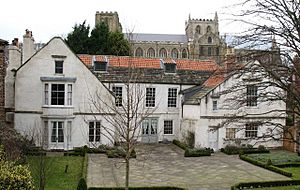
In the 16th century, Ripon started making spurs instead of textiles. These spurs were so famous that a saying, "as true steel as Ripon Rowels," came from them. Spurs were not just for riding; they were also a fashion item. A very expensive pair was made for King James I when he visited Ripon in 1617.
It was King James who gave Ripon its Royal Charter in 1604, creating the first Mayor of Ripon. In 1640, a treaty was signed in Ripon to end a conflict between King Charles I and the Scottish Covenanters.
During the English Civil War, Ripon remained loyal to the King. In 1643, Parliamentarian forces damaged the Minster, but Royalist forces quickly fixed things. The Royalists eventually lost the war, and Charles I was held prisoner in Ripon for two nights. Oliver Cromwell also visited the city twice on his way to battles.
After the Civil War, different Christian groups appeared, though most people in Ripon were Anglicans with a small Catholic group. After the Revolution of 1688, there were some uprisings to bring back King James II. Some Ripon men were jailed for supporting this.
John Wesley, who started Methodism, preached in Ripon, and a small group of his followers was formed. During the Georgian era, Ripon was not greatly changed by the Industrial Revolution. John Aislabie, a local Member of Parliament, created the beautiful Studley Royal Park with its water garden. He also put up the obelisk in the market square. Newby Hall was also built during this time.
Modern Ripon
Travel became easier when Ripon railway station opened in 1848. During the First World War, a large military training camp was built in Ripon. The local community welcomed soldiers' wives and even refugees from Belgium. Ripon played a similar, though smaller, role in the Second World War. Because of this, the Royal Engineers were given the Freedom of the City in 1947.
Since the wars, Ripon has grown and changed. It now attracts thousands of tourists each year. They come to see its famous buildings, its long Christian history, nearby Studley Park, Ripon Racecourse, and the theme park Lightwater Valley.
City Status
Ripon was the first place in the Church of England to become a diocese after the English Reformation in 1836. This happened because existing dioceses were too big for the growing population. Ripon's important parish church was made into a cathedral. The Ripon council then started calling the town a city.
Later, in 1853, Manchester officially became a city by asking the monarch. Ripon was encouraged to do the same, and its city status was recognized by an act of Parliament in 1865.
In 1974, the Ripon borough was changed as part of local government reform. The city status was then given to the Ripon City Council, which is a local parish council. This means the whole area managed by the parish council, including the town and some nearby rural land, is considered the city.
Ripon has the third smallest population of all cities in England. However, when looking at the whole UK, it ranks seventh.
How Ripon is Governed

Ripon became a municipal borough in 1835, with its main office at Ripon Town Hall. It remained an independent borough until 1974. That year, Ripon merged with the Harrogate borough and other areas to form a larger Harrogate borough in North Yorkshire.
The local government for Ripon is the Ripon City Council. This is a parish council with twelve members. In 2019, four of these councillors were from the Conservative Party, and the rest were independent.
Ripon used to have its own Members of Parliament (MPs) starting in 1553. At first, only certain landowners could vote. The Great Reform Act of 1832 changed this. The Reform Act of 1867 reduced Ripon's representation from two MPs to one. Famous MPs from Ripon included John Aislabie and Frederick John Robinson.
In 1885, the Ripon borough for Parliament was removed. However, the area where Ripon was located was still called Ripon for elections until 1983. Since 1983, Ripon has been part of the Skipton and Ripon constituency, which is usually won by the Conservative Party.
| Position | Current representatives |
|---|---|
| Member of Parliament | Julian Smith, Conservative, elected 2010 |
| City Council Members | elected 2018: Jo Bate, Independent · Michael Chambers, Conservative · Stephen Michael Craggs, Conservative · Christopher James Davis, Conservative · Anthony Christopher Hardisty, Independent · Sid Hawke, Independent · Peter Horton, Independent · Pauline McHardy, Independent · Stuart Martin, Conservative · Eamon Robin Parkin, Independent · Charlie Powell, Independent · Andrew Williams, Independent |
Geography and Climate
Rivers and Landscape
Ripon is located where two rivers, the Laver and the Skell, meet. These rivers then join the River Ure east of the city. The Ripon Canal also connects to the River Skell. The River Ure used to be the border between the old West and North Ridings of Yorkshire.
Because Ripon is at the meeting point of three rivers, it has often experienced floods. Major floods happened in 1982, 1991, 1995, 2000, 2005, and 2007. To prevent future floods, over £14 million has been spent on building flood defenses and a large water storage area upstream.
The ground in the Ripon area is mostly magnesian limestone. There are also pockets of gypsum underground. When water dissolves the gypsum, it can create sinkholes, especially north of the city.
Weather in Ripon
The weather information below is from Topcliffe, which is about 13 km (8 miles) north-east of Ripon.
| Climate data for Topcliffe airfield (North Yorkshire): elevation: 25 m (82 ft) Average maximum and minimum temperatures, and average rainfall recorded between 1991 and 2020 by the Met Office. Sunshine hours are for Leeming, as no data has been recorded at Topcliffe. |
|||||||||||||
|---|---|---|---|---|---|---|---|---|---|---|---|---|---|
| Month | Jan | Feb | Mar | Apr | May | Jun | Jul | Aug | Sep | Oct | Nov | Dec | Year |
| Mean daily maximum °C (°F) | 6.8 (44.2) |
7.4 (45.3) |
9.9 (49.8) |
12.5 (54.5) |
15.7 (60.3) |
18.2 (64.8) |
20.9 (69.6) |
20.4 (68.7) |
17.7 (63.9) |
13.6 (56.5) |
9.5 (49.1) |
6.7 (44.1) |
13.3 (55.9) |
| Mean daily minimum °C (°F) | 0.4 (32.7) |
0.1 (32.2) |
1.5 (34.7) |
3.2 (37.8) |
5.8 (42.4) |
8.9 (48.0) |
11.2 (52.2) |
10.6 (51.1) |
8.4 (47.1) |
5.6 (42.1) |
2.4 (36.3) |
-0.0 (32.0) |
4.86 (40.75) |
| Average precipitation mm (inches) | 55.3 (2.18) |
39.5 (1.56) |
45.4 (1.79) |
53.3 (2.10) |
42.7 (1.68) |
59.7 (2.35) |
54.1 (2.13) |
62.5 (2.46) |
50.5 (1.99) |
58.7 (2.31) |
63.3 (2.49) |
58.9 (2.32) |
644 (25.4) |
| Average precipitation days (≥ 1.0 mm) | 10.9 | 8.7 | 10 | 9.3 | 8.8 | 9.1 | 9.8 | 9.9 | 9.0 | 10.4 | 10.9 | 11.1 | 117.9 |
| Mean monthly sunshine hours | 58.1 | 81.7 | 121.5 | 153.8 | 195.0 | 175.9 | 185.5 | 171.2 | 132.7 | 93.4 | 63.7 | 54.2 | 1,486.7 |
| Source 1: Met Office | |||||||||||||
| Source 2: Met Office | |||||||||||||
Famous Buildings and Architecture
The most important building in Ripon is its English Gothic style cathedral. It was first built by Irish monks but then rebuilt by Saint Wilfrid in 672. The cathedral has been rebuilt many times, but the Saxon crypt is the only original part left. Saint Wilfrid's grave is also there.
Ripon Spa Baths is a historic building that opened in 1905. Originally, spa water was brought from a nearby village. Later, the baths also used water from the site itself. The baths closed in 2021 and were bought in 2024 to be turned into a hotel and apartments.
Education in Ripon
Ripon is home to Ripon Grammar School, a selective state secondary school. The school believes its roots go back to a school connected to the Collegiate Church, founded by Saint Wilfrid during the time of the Angle kingdom of Northumbria. The school was officially re-founded in 1555 during the reign of Queen Mary I.
Many famous people have attended Ripon Grammar School, including Bishop Beilby Porteus, historian Bishop William Stubbs, fashion designer Bruce Oldfield, and TV presenter Richard Hammond. Today, the school has about 800 students and is highly rated.
Across from Ripon Grammar is Outwood Academy Ripon (formerly Ripon College). This school has about 630 students and performs well in GCSE exams.
Ripon also used to have higher education facilities with the College of Ripon and York St John until 2001. This college started as two teacher training colleges in York. The women's college moved to Ripon in 1862. The colleges merged in 1974 and later became part of the University of Leeds. In 2001, all activities moved to York, and the college became York St John University. One of York St John's buildings was renamed 'Ripon' in 2018 to remember Ripon Training College's important role in women's education.
Evolve is a small college in Ripon for students over 16, working with Craven College.
On the edge of Ripon is Spring Hill, a special school for children with autism. It offers both day and boarding places. The school is owned by Cambian group PLC, a large provider of specialist education.
Religion in Ripon
Christianity is the largest religion in Ripon. In the 2001 census, 79.3% of people in the area said they were Christian. Ripon Cathedral is the main religious building. It has a tomb believed to hold the bones of Saint Wilfrid, who founded a monastery here. William Gibson was another important local figure, a Catholic martyr.
The Church of England is the main Christian group, with Ripon Cathedral and Holy Trinity Church. Ripon is the home of the Bishop of Ripon and Leeds, a religious leader. There is also a Roman Catholic parish in Ripon called St. Wilfrid's. Additionally, there are a couple of places of worship for Methodism.
Culture and Traditions
Ripon holds a market day every Thursday with 120 stalls. Every year, the Wilfrid Procession celebrates the city's founder. This tradition started in 1108 when King Henry I allowed a fair to be held. In the procession, decorated floats travel through the city, with locals dressed in costumes. Part of the tradition shows Wilfrid returning to Ripon, with a decorated dummy or a person dressed as Wilfrid on a horse. Ripon also has traditional dances like the Long Sword dance and Morris dance.
The market square features the Ripon Obelisk, built in 1702 by John Aislabie. It is 80 feet (24 m) tall and has a weathervane shaped like the wakeman's horn. It is considered the oldest obelisk in England.
The tradition of the Ripon Hornblower has continued since 886. It comes from the "wakeman" of Ripon, who was like a mayor in the Middle Ages and responsible for law and order. Every day at 9:00 pm, the horn is blown at the four corners of the obelisk in Ripon Market. The horn is now a symbol of the city and is on the Harrogate borough coat of arms.
Ripon has three museums known as the Yorkshire Law and Order Museums. These include the Courthouse, the Prison and Police Museum, and the Workhouse Museum.
Sports in Ripon
The most famous sport in Ripon is horse racing at Ripon Racecourse. Horse racing has a long history here, with the first recorded race in 1664. The current racetrack has been used since 1900. Ripon held Britain's first race for female riders in 1723.
The city is also home to Ripon Rugby Union Football Club, founded in 1886. They currently play in Yorkshire 2, which is the eighth level of the English Rugby Union league.
Local Media
Local news and TV shows for Ripon are provided by BBC Yorkshire and ITV Yorkshire.
Local radio stations include BBC Radio York, Greatest Hits Radio Yorkshire, 'Your Harrogate', and BFBS (for the armed forces).
The Ripon Gazette is the city's weekly local newspaper.
Transport in Ripon
Ripon used to have a Ripon railway station on the line between Leeds and Northallerton. This line was closed in the 1960s. Today, much of the old railway route through the city is now a relief road. Although the old station building is still there, it's surrounded by new houses. There are ongoing efforts to reopen the railway line between Ripon and Harrogate. Reports suggest this would be good for the economy and could attract many passengers.
By road, Ripon is easy to reach. The A1(M) motorway connects to Ripon via the B6265. The A61 is the main road that runs through the city.
The Harrogate Bus Company's route 36 connects Ripon to Harrogate and Leeds. There are also regular bus routes to other towns like Boroughbridge, York, and Thirsk.
The Ripon Canal was built in 1766 to connect the city center to the River Ure. It was used to transport coal into the city. The canal was closed in 1956 but was partly reopened in 1988 and fully reopened in 1996 after a conservation effort.
Twin Towns
- Foix in France (since 1957).
Freedom of the City
The following people and military groups have been given the special honor of Freedom of the City of Ripon:
Individuals
- Charles, Prince of Wales: October 24, 2002.
Military Units
- The Royal Engineers: July 27, 1949.
- RAF Leeming: September 14, 2015.
Images for kids
See also
 In Spanish: Ripon para niños
In Spanish: Ripon para niños


